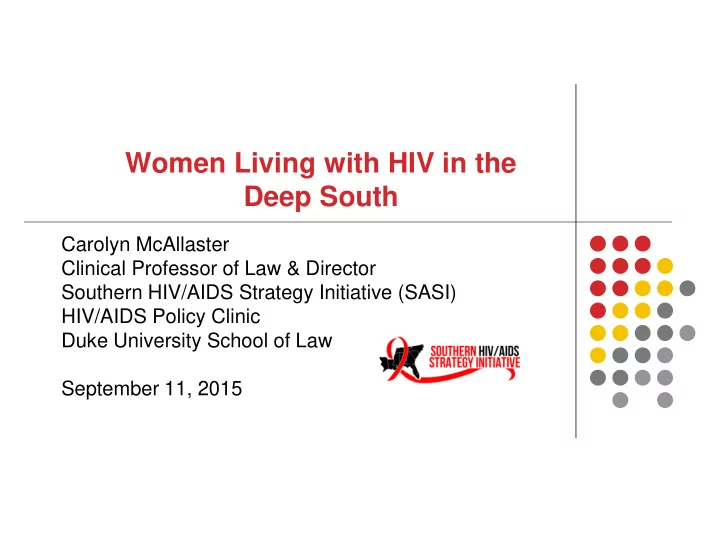

Women Living with HIV in the Deep South Carolyn McAllaster Clinical Professor of Law & Director Southern HIV/AIDS Strategy Initiative (SASI) HIV/AIDS Policy Clinic Duke University School of Law September 11, 2015
Southern HIV/AIDS Strategy Initiative (SASI) Initiative Funded by Ford and Elton John AIDS Foundation; Uses Research-based advocacy to push for increased attention and resources targeting the Southern epidemic; Target 9 Deep South states that share common characteristics: Overall poorer health High poverty rates Cultural climate that contributes to spread of HIV AL, FL, GA, LA, MS, SC, NC TN, TX . Steering Committee of PLWH and advocacy allies from 9 states. Research Team from the Duke Center for Health Policy & Inequalities Research
HIV in Women & Girls in the US
HIV Surveillance Data- 2008-2012 The targeted states region had the highest HIV diagnosis rate of any US region in 2008-2012 (CDC Atlas database)
Number of HIV diagnoses – 2008-2012
CDC/SASI Collaboration CDC/SASI Collaboration: “HIV Diagnoses, Prevalence and Outcomes in Nine Southern States,” Journal of Community Health, 2014 Targeted states had higher proportions of HIV diagnoses that were female , black or African American , young (age 13-24) and living in a rural area than US average. 23.3% of new diagnoses in the Deep South region were female (US average = 20.9%) Targeted states also had a higher percentage of persons living with HIV who were female (27.7%) than US average (24.9%)
AIDS Diagnosis Rates – 2008-2012 The AIDS diagnosis rates and number of individuals diagnosed were higher in the targeted states than any other US region.
HIV Survival 5-year HIV survival for persons diagnosed 2003-2004 was lower in the targeted states (85%), indicating that 15% of those diagnosed with HIV in 2003-2004 had died within 5 years. In the target states, HIV survival was lower among women , black/African Americans and persons living in rural areas than the US average. HIV survival rate within the region was equal for men & women. Injection drug use strongly associated with lower 5-year survival. Louisiana had the lowest 5-year survival percentage (81%) followed by Mississippi (83%) and South Carolina (84%)
AIDS Survival For 5-year survival after an AIDS diagnosis , the targeted states had the lowest survival percentage of any region (73%), indicating that 27% of those diagnosed with AIDS in 2003- 2004 had died within 5 years. Again, Louisiana had the lowest AIDS survival percentage ( 67% ) followed by Mississippi ( 68% ) and Alabama ( 69% )
AIDS Survival Among Women in the Deep South In the targeted states, AIDS survival was lowest among women , black/African Americans , and those living in rural areas. 29% of females diagnosed with AIDS in this region had died within 5 years of diagnosis. (compared to 26% of males.)
Death Rates Death rates among those living with HIV in the Deep South region were higher than in any other region. (27.3 per 1,000) Death rates among women living with HIV in the Deep South region were higher than among males (28.2 compared to 26.9) Highest death rates were in Louisiana (34.5) followed by Alabama (30.7) and Mississippi (28.6) CDC estimates that of all women living with HIV in the US, only 45% were engaged in care and only 32% had achieved viral suppression.
10 MSAs with the highest AIDS Diagnosis Rates -- 2012
Challenges to achieving positive outcomes in the Deep South A higher % of the region’s epidemic is outside large urban centers: Transportation issues Lack of qualified providers High levels of HIV-related stigma
Challenges to achieving positive outcomes in the Deep South (cont’d) Region as a whole faces: High poverty High numbers of uninsured persons Lower educational levels High levels of stigma and racism
Additionally… (From the SASI/CDC Report): “An additional contributing factor may be the social class system unique to the US South that has traditionally allowed for little social mobility, along with marginalization of, and discrimination against certain groups and often resulting in distrust of systems of care among those in a lower social strata.” These factors collectively create an environment in which HIV infection is more likely and health outcomes for HIV positive people are poorer than in other US regions.
For More Information: Southern HIV/AIDS Strategy Initiative (SASI): Sign up for SASI list serve: sasi@law.duke.edu SASI website: www.southernaidsstrategy.org SASI research reports: http://southernaidsstrategy.org/research/ Southern AIDS Coalition (SAC) Sign up for SAC list serve: info@southernaidscoalition.org SAC website: www.southernaidscoaltion.org
Recommend
More recommend